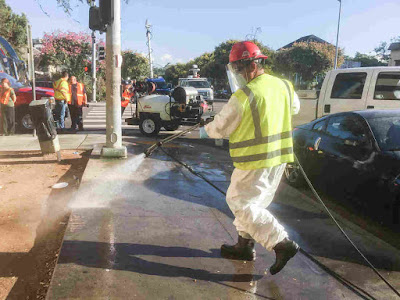Is San Diego In Compliance With Their Own Storm Water Regulations?
The San Diego Storm Water Management Unit's main focus is in implementing permitting, compliance, and other activities to reduce pollutants in municipal, construction, and industrial storm water runoff.
The City of San Diego enacted San Diego Municipal Code (SDMC) §43.03 entitled Storm Water Management and Discharge Control in 1993, commonly referred to as the City’s storm water ordinance. This ordinance, in a nutshell, makes it unlawful for any person to discharge non-storm water into the City’s storm water conveyance system.
For contractors, this means that concrete slurry, stucco, sediments, paint, and other disposal of materials into the street gutter or storm drain are illegal discharges.
The intent of the ordinance is to protect and enhance the water quality of our watercourses, water bodies, and wetlands in a manner consistent with the federal Clean Water Act. The storm water conveyance system collects storm water and urban runoff containing pollutants and discharges these flows untreated into the creeks, rivers, bays, and ocean.
The STORM WATER STANDARDS Manuel (January 20, 2012) is one hundred and seventy-nine pages deep. In addition, the enforcement remedies have been increased to maximum civil penalties or fines of $10,000 per day per violation; up from $2500!
Back in March of 2017, San Diego Health Officials declared a Hepatitis A Outbreak. The county explained that Hepatitis A was spreading “through contact
with a fecally contaminated environment.” This disease is a highly
contagious liver infection caused by a virus. It is spread
person-to-person typically through poor sanitation practices, such as
not washing hands after using the restroom.
However, the problem was mostly ignored until September 2017 and then only after three hundred and thirty cases were documented and fifteen people died from Hepatitis A. It became the second largest outbreak in the United States.
Then "America's Finest City" sprang into action and immediately begin power-washing our streets with bleach to fight a deadly hepatitis outbreak
Contractors (Clean Harbors) started spraying down areas with a diluted household bleach solution. The procedure, as prescribed by the county, involves first spraying down hazardous items such as human waste or needles, waiting 10 minutes, removing the contaminated items, then spraying the area again with bleach. After that, it calls for pressure-washing the area with water.
It is set to be repeated every two weeks, with weekly "spot maintenance," according to county guidelines.
My concern is that in every photo and/or video found of the cleanup efforts, the contaminated water, chlorine and bleach are just being allowed to drain into the City’s storm water conveyance system!
What research, if any, has been completed that states this is the best method of containment? How will this water runoff, containing human fecal matter, bleach, the Hepatitis A virus and other poisonous material, effect San Diego environment and water quality? Will it kill all the plants and trees in the treatment area? Will beach goers suffer from contamination?
What will the bleach fumes do to air breath-ability? Bleach does emit fumes that can be dangerous when inhaled.
The fear that this solution might be worse than the original problem looms heavy.




Loading and unloading comes as a part and parcel of our moving services. In case you are particular about use of machinery for loading and unloading, you can get your option through one of our providers. For very professional and fully managed relocations, opt for our VManage Premium package.
ReplyDeletepackers and movers dhanbad
packers and movers thrissur
packers and movers in belgaum
packers and movers kharagpur
packers & movers in nagpur
packers and movers btm layout
packers and movers pondicherry
ReplyDeletepackers and movers satna
packers and movers bhilai
packers and movers in cuttack
packers and movers in durgapur
packers and movers in meerut
packers and movers rajahmundry
packers movers jodhpur
packers and movers kakinada
packers and movers korba
packers and movers coimbatore
ReplyDeletepackers and movers in nashik
packers and movers in panchkula
packers and movers in zirakpur
packers and movers allahabad
packers and movers in amritsar
packers and movers mangalore
packers and movers bilaspur
packers and movers in ajmer